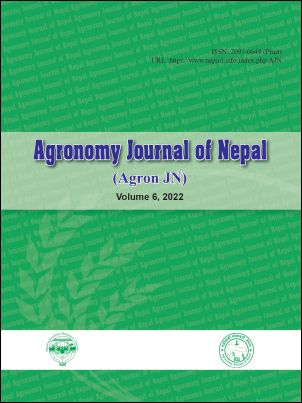Impact of Sowing Dates on Wheat Varieties in Central Terai Region of Nepal
DOI:
https://doi.org/10.3126/ajn.v6i1.47966Keywords:
Date of sowing, varieties, wheat, yieldAbstract
A suitable time of sowing and varieties are the most important factors for getting higher yield of wheat. To evaluate the effect of different sowing times on wheat varieties, an experiment was conducted at Directorate of Agricultural Research (DoAR), Madhesh Province, Parwanipur, Bara, Nepal during the winter seasons of 2018-2019. The experiment was conducted in a split-plot design with three replications that includes twelve treatments combination having three sowing dates as a main-factor ( 10th November, 25th November, and 10th December) and four promising wheat varieties (BL 4407, BL 4621, BL 4699, and Vijay) as a sub-factor. There was a significant effect of date of sowing on spike length, tillers, grain yield and 1000 grains weight, but the plant height and straw yield were not affected significantly by sowing dates. Variety had no significant effect on plant height and straw yield, but influenced significantly the spike length, effective tillers, 1000 grains weight and grain yield. The 25th November sown wheat crop gave a significantly higher grain yield (3925 kg ha–1) and straw yield (8044 kg ha–1) but declined in grain yield noted by 11-14% in the 10th November and 10th December sown wheat. A promising wheat variety BL 4407 (4017 kg ha–1) produced the highest yield, (20% more) compared with released variety Vijay (3203 kg ha–1). It can be concluded that proper time of sowing and selecting appropriate variety enhanced the grain yield of wheat.
Downloads
Downloads
Published
How to Cite
Issue
Section
License
Copyright (c) 2022 Agronomy Society of Nepal (ASoN)

This work is licensed under a Creative Commons Attribution-NonCommercial 4.0 International License.
ASON permits for free use, distribution and reproduction in any medium if the original work is properly cited and not used for commercial purposes.




